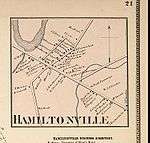Guilderland (hamlet), New York
Guilderland is a hamlet of the town of the same name in Albany County, New York.
Guilderland | |
|---|---|
hamlet | |
 Guilderland Location of Guilderland within the state of New York | |
| Coordinates: 42°42′14″N 73°54′43″W | |
| Country | United States |
| State | New York |
| Region | Capital District |
| County | Albany |
| Settled | 1796 |
| Time zone | UTC-5 (EST) |
| • Summer (DST) | UTC-4 (EDT) |
| ZIP Code | 12084 |
| Area code(s) | 518 |
History

The hamlet of Guilderland was begun as a glass factory in 1792, often referred to as the "Glass House".[1] This factory was in the middle of the wilderness of the Pine Bush pine barrens, in an area then called Dowesburgh.[2] In 1796, with hopes of establishing a manufacturing village, streets and lots were laid out and sold, and 54 houses built for the factory workers.[3] This little village was named Hamilton for Secretary of Treasury Alexander Hamilton, an Albany native and a Founding Father of the United States. When the Great Western Turnpike was built through the hamlet in 1799 connecting Albany to the western frontier, Hamilton became the home to several taverns and other businesses catering to the pioneers.[2] The glass works here folded in 1815, ending the hopes of this place becoming a major factory town. Hamilton would get its first post office in 1815 as well, the post office though would take the name Guilderland instead, and the community would come to be known locally as Sloan's, for the owner of the major hotel here.[2][3] The Hamilton name continues to live on in the name of a Presbyterian church, the Hamilton Union Presbyterian Church that was founded in 1824.[4]
Geography
As a hamlet Guilderland has ill-defined boundaries but is generally considered to be along US Route 20 (Western Avenue) between New York Route 155 (State Farm Road/New Karner Road) and New York Route 146 (south-leg to Altamont).[5]
Location
Important locations
- Prospect Hill Cemetery
- Guilderland Elementary School
- Guilderland Public Library
- Guilderland YMCA
- Western Turnpike Golf Course
See also
References
- George Howell and Jonathan Tenney (1886). Bi-Centennial History of Albany: History of the County of Albany from 1609-1886. W.W. Munsell and Company. p. 855. Retrieved 2010-02-10.
- Alice Begley and Mary Ellen Johnson (1999). Guilderland, New York. Arcadia Publishing. pp. 29–32. ISBN 0-7385-0112-3. Retrieved 2010-02-14.
- George Howell and Jonathan Tenney (1886). Bi-Centennial History of Albany: History of the County of Albany from 1609-1886. W.W. Munsell and Company. pp. 851–2. Retrieved 2010-02-10.
- "Hamilton Union Presbyterian Church: Church History". Hamilton Union Presbyterian Church. Retrieved 2010-02-17.
- Anne Miller (January 19, 2003). "Neighbor Groups Seek Designs Beyond Box". Albany Times Union. p. E1. Retrieved 2010-02-15.

